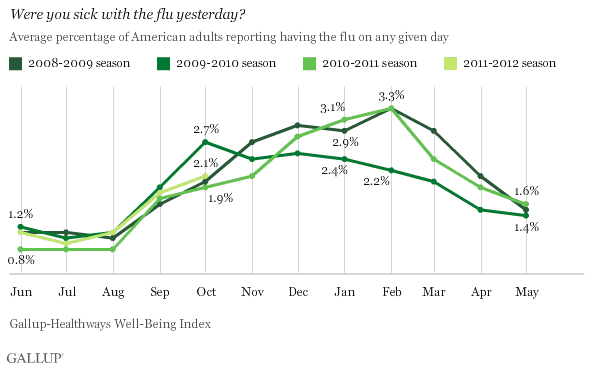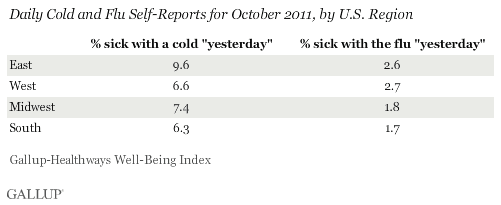WASHINGTON, D.C. -- Americans' self-reports of the flu are rising at the expected rate and are tracking at nearly identical levels of last year. An average of 2.1% of Americans in October reported having the flu the day before the survey, similar to the levels found in October of last year and in 2008, but slightly lower than the 2.7% in 2009.

The Gallup-Healthways Well-Being Index asks 1,000 Americans each day whether they had a cold or the flu "yesterday." In general, the percentage of Americans who report they had a cold on any given day is roughly three times greater than the percentage who report they had the flu.
The 2009-2010 cold and flu season is associated with the H1N1 pandemic. Gallup data reveal unusually high rates of reported cold and flu incidences through October of that season, before dropping to below-typical rates thereafter.
The measurement of colds versus the flu in a survey research environment is complex because of the overlapping symptoms of the two disease conditions and many Americans' misunderstanding of which symptoms constitute "the flu" versus "a cold."
It is also possible that the estimate of daily cold and flu prevalence is underestimated, as would-be respondents who were sick the day before may be less likely to respond to a phone survey than those who were not sick. Still, Gallup's measurement approach -- asking the same question in the same survey day after day -- holds these factors constant, thus providing valuable trends for evaluating changes from month to month and year to year.
Reported Colds Increase in October, but on Par With Previous Years
An average of 7.3% of Americans reported having a cold in October, up from 5.5% in September. The prevalence of colds last month is on par with the same month in 2010 (6.7%) and 2008 (7.0%). Only in 2009 -- the year of the H1N1 pandemic -- was the percentage of Americans who reported having a cold slightly higher, at 7.7%.

Colds Abound in the East, While Flu Takes Hold in the East and West
Although daily reports of colds and the flu increased nationwide in October, those living in the East were hit the hardest. Nearly 10% of Americans in the East reported being sick with a cold the day before the survey in October -- significantly more than in any other region.
Americans in the East and West were slightly more likely than those in the South and Midwest to report having the flu. This could reflect the unusually cool October weather in the southern part of the East region and the early winter weather in the Northeast late in the month, keeping more people indoors and giving colds and flu viruses better opportunity to spread.

Bottom Line
Americans' average daily reports of colds and the flu are nearly identical to previous years so far in the 2011-2012 season and are somewhat below the levels reported in the 2009-2010 season. The Centers for Disease Control and Prevention, which tracks clinically confirmed influenza via collaborating laboratories in all 50 states and the District of Columbia, has reported low levels of clinically observed influenza so far this year, with rates consistent with typical expectations.
Many public health analysts have been cautiously optimistic that this cold and flu season will be typical, as was the case in 2010-2011. Thus far, the Gallup-Healthways data reveal that these projections of a modest season are accurate. Gallup will continue to track self-reported cold and flu cases throughout the 2011-2012 season.
About the Gallup-Healthways Well-Being Index
The Gallup-Healthways Well-Being Index tracks well-being in the U.S., U.K., and Germany and provides best-in-class solutions for a healthier world. To learn more, please visit well-beingindex.com.
Survey Methods
Results are based on telephone interviews conducted as part of the Gallup-Healthways Well-Being Index surveys, with a random sample of 29,500 adults per month, aged 18 and older, living in all 50 U.S. states and the District of Columbia, selected using random-digit-dial sampling.
For results based on the total sample of national adults, one can say with 95% confidence that the maximum margin of sampling error is ±0.6 percentage points.
One of the questions on the survey asked each day is "Were you sick with any of the following yesterday?" The questions specifies four illnesses: the flu, a cold, a headache, and allergies. Respondents are not asked to indicate whether they had received a clinical diagnosis of H1N1 or other types of influenza via a healthcare professional.
Interviews are conducted with respondents on landline telephones and cellular phones, with interviews conducted in Spanish for respondents who are primarily Spanish-speaking. Each sample includes a minimum quota of 400 cell phone respondents and 600 landline respondents per 1,000 national adults, with additional minimum quotas among landline respondents by region. Landline telephone numbers are chosen at random among listed telephone numbers. Cell phone numbers are selected using random-digit-dial methods. Landline respondents are chosen at random within each household on the basis of which member had the most recent birthday.
Samples are weighted by gender, age, race, Hispanic ethnicity, education, region, adults in the household, and phone status (cell phone only/landline only/both, cell phone mostly, and having an unlisted landline number). Demographic weighting targets are based on the March 2010 Current Population Survey figures for the aged 18 and older non-institutionalized population living in U.S. telephone households. All reported margins of sampling error include the computed design effects for weighting and sample design.
In addition to sampling error, question wording and practical difficulties in conducting surveys can introduce error or bias into the findings of public opinion polls.
For more details on Gallup's polling methodology, visit www.gallup.com.
